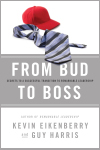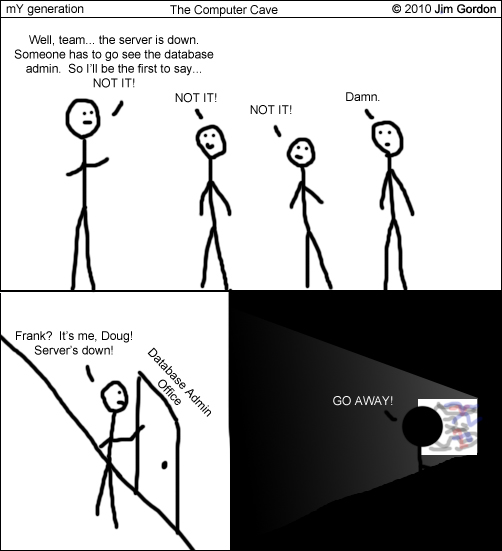|
|
|
Friday, February 27th, 2015
A Friday series exploring Startups and the people who make them go. Read all If the Shoe Fits posts here
 Yesterday we talked about open communications and how powerful it is when part of cultural DNA. Yesterday we talked about open communications and how powerful it is when part of cultural DNA.
Visual communication was recommended, with the caveat, “processes and information that can not be represented visually are probably too convoluted and bureaucratic.”
XPLANE’s Dave Gray seems to agree.
Every company has a culture, but it can take time to learn, and the stated culture can often differ significantly from what people actually experience.
At XPLANE we have created a visual map of our culture, to guide our teams in daily decision making and help them make choices that are consistent with what we stand for and who we want to be.
Smart; very smart.
 What does your culture look like? What does your culture look like?
Image credit: HikingArtist
Posted in Communication, Culture, If the Shoe Fits | No Comments »
Friday, February 20th, 2015
A Friday series exploring startups and the people who make them go. Read all If the Shoe Fits posts here.
 If anything has changed in the 21st Century it’s the recognition that culture is everything — the true “make or break” for any company. If anything has changed in the 21st Century it’s the recognition that culture is everything — the true “make or break” for any company.
Knowing that, founders, of all people, should know better than to do anything that undermines their culture.
And yet they do it all the time.
One of the worst is also one of the commonest — having two teams
- the one to which they pay lip-service and talk about in public; and
- the one that has their ear, takes priority and stays front and center in all decisions.
Founders constantly refer to their “team” and it’s taken to mean all the company’s employees.
But, for those the shoe fits, it actually refers to their stars, their pets and all (most?) of their direct reports.
This was a common attitude in larger companies, but at least it was honest; bosses were ‘us’, workers were ‘them’ and everybody knew where they stood.
The changes started when Volvo focused the world on the power of teams, research showed that productivity increased when people were more invested and engaged in their work and terminology was introduced that is inclusive and empowering.
Fast forward to now and that language is in common use, but, as with most things, it can be distorted and perverted.
Founders, like other bosses, fall in two categories.
- Those who buy it, own it, use it and mean it;
- and those who use it to keep everyone in line who’s not on the ‘real’ team.
Which are you?
And before you claim the first bullet take a good look at your past actions.
In fact, get some feedback from someone you know will tell you the truth, as opposed to what you already “know” or want to hear.
Image credit: HikingArtist
Posted in Culture, If the Shoe Fits | No Comments »
Monday, April 7th, 2014

How do you start your day?
Do your colleagues and boss jump on you with questions, demands and complaints?
Or are there congenial greetings, happy how-are-yous and questions displaying authentic interest in you-the-person?
Other than perpetual curmudgeons and people who got up on the wrong side of the bed, most people would prefer the second scenario to the first.
Bosses should take note, because the second scenario leads to higher productivity and better retention rates.
Wharton management professor Sigal Barsade has solid research to back that up, but, in my view, she badly undermined its adoption by choosing to describe it in terms that will turn off most managers.
She calls it “companionate love.”
Companionate love is shown “when colleagues who are together day in and day out, ask and care about each other’s work and even non-work issues. They are careful of each other’s feelings. They show compassion when things don’t go well. And they also show affection and caring — and that can be about bringing somebody a cup of coffee when you go get your own, or just listening when a co-worker needs to talk.”
Why don’t experts, especially academic experts get it? Why is it so difficult to understand that what something is called affects it in the marketplace?
From about age two on (maybe even younger) humans react to what something is called, whether a product or an action, and that reaction is a good predictor of success.
In today’s world, to succeed, management advice needs to develop terms that wrap the user in a mantle of cool while projecting an image of knowledge and leadership.
Sadly, ‘companionate love’ seems to fall short.
But that doesn’t mean you can’t implement the underlying philosophy or respect, consideration and interest using terms more acceptable to your situation.
Flickr image credit: jon oropeza
Posted in Communication, Culture, Personal Growth | No Comments »
Friday, April 4th, 2014
A Friday series exploring Startups and the people who make them go. Read all If the Shoe Fits posts here

I hear a lot of bull disguised as best practice from founders (and other bosses) regarding hiring and management.
- We only hire stars.
- All our people are self-starters.
- Our people are self-managing.
- We’re not into hand-holding here.
And all forms of variations on the theme.
The reason it’s bull is that most people prefer to be part of a cohesive team (think family)—with the exception of those who are out for themselves and their own glory.
The smartest founders know that it’s the power of the team that confers long-term success.
Christopher W. Cabrera, founder, president and CEO of nine-year-old Xactly is a good example.
He has a 300 person workforce, mostly in their early thirties, which means most were in their twenties when hired.
He uses a prominently displayed rubber band ball to drive home how the company works.
Every month we have an all-hands meeting where every new employee puts their rubber band on the ball. Rubber bands come in all different sizes, shapes and color. Together, when they’re combined, they take on a whole new set of properties and the ball can be bounced or thrown where an individual rubber band can’t. So our motto is, “That’s how we roll.” Somewhere in that ball is my own rubber band. There is no single band in there that’s more important than any other. It’s the collective that counts. Our employees are part of something bigger and we’re trying to build something great.
Take note: no stars.
Hall of Famer and current SMU (turnaround) basketball Coach Larry Brown puts it this way,
“They all want to be coached. They all want to get better. They all want somebody who cares about them.”
Which pretty well sums it up.
A place to make a difference and a boss that gives a damn.
Image credit: HikingArtist
Posted in Culture, If the Shoe Fits | No Comments »
Friday, October 18th, 2013
A Friday series exploring Startups and the people who make them go. Read all If the Shoe Fits posts here
 Founders are much like football (and other sports) coaches when it comes to managing their people. Founders are much like football (and other sports) coaches when it comes to managing their people.
Coaches are notorious for accepting/ignoring bad behavior, especially from key players, in the name of winning.
And while that may work in the very short term, longer-term results usually plunge and indirect collateral damage escalates.
Founders often hire “stars” and cut them the same kind of slack when they act out, with far more serious effects.
In fact, tolerating the bad attitude and actions of a few stars can either spread to the whole team or tear it apart and destroy it.
Not all coaches turn a blind eye.
With reports of poor grades, cyberbullying and attitude problems, the coaches were unwilling to support the declining behavior of their team. So just before the homecoming game, they suspended all 80 players.
Doing that meant forfeiting the game, but what then?
They gave every player the opportunity of earning their way back on the team.
Head coach Matt Labrum reset the standard of acceptable behavior. He clearly articulated what was needed, provided support to develop the vital skills, and raised the bar on what was expected. Players knew exactly what choices were required to remain on the team.
Notice they weren’t just told to improve or stop X, they were given clear goals, the support to achieve them and were held accountable.
No company succeeds based only on its so-called stars.
Just as “it takes a village to raise a child” it takes a team to build a successful company.
It also takes a founder willing to draw the line and hold it in a constructive and meaningful way.
Image credit: HikingArtist
Posted in Personal Growth | No Comments »
Tuesday, January 10th, 2012
 I have often heard managers refer to their job as “herding cats;” this is especially true in technical fields where much of the work requires individual efforts. I have often heard managers refer to their job as “herding cats;” this is especially true in technical fields where much of the work requires individual efforts.
Scientists are probably the most difficult, since they often come from an environment where publish or perish is the mantra and egos are super-sized.
This was the difficulty that David Ferrucci faced when he set about building the team that created Watson for IBM. He not only had to herd cats he had to hire cats.
As most of the world knows, Ferrucci’s team was wildly successful and created a computer that won playing Jeopardy against its two top past champions and is moving on to far greater challenges.
He says, “In the end, the hero was the team, not any individual member or algorithm.”
What do the researchers think? This comment from one of them pretty much says it all, “Compared to the way we work now, it’s like we were standing still before.”
These scientists are all considered ‘stars’ in their respective fields, but none of them could do anything close to Watson on their own.
Nor could they have done it if their egos and desire for personal recognition had stayed their driving force.
“As for the members of the original Watson team, they’d tell you that never in a million years could they have imagined what we accomplished. Just like Watson itself, we all learned that the sum is much greater than the parts.”
Hiring and herding cats is the true talent of a great manager/leader and absolute proof that in today’s world the boss needs to be both.
And Watson is proof positive that the only stars worth having are the ones who join the team.
Flickr image credit: Bengt Nyman
Posted in Ducks In A Row, Innovation | 1 Comment »
Tuesday, February 15th, 2011
 This is a guest post from Becky Robinson, who writes Weaving Influence, and is also working with Kevin Eikenberry on the launch today of his new book, From Bud to Boss; Becky is Director of Social Media Marketing and Community Building. This is a guest post from Becky Robinson, who writes Weaving Influence, and is also working with Kevin Eikenberry on the launch today of his new book, From Bud to Boss; Becky is Director of Social Media Marketing and Community Building.
In all honesty I haven’t read the book, but I can say that Kevin is well-grounded and typically gives solid, common sense advice.
In this post, Becky offers up her own savvy input on the importance of team support.
The Final Mile
If you’ve worked on a big project lately, you know that fatigue can set in as you approach the final days before the launch.
In mid-December, I joined a new team to help with the promotion of a new book, due out for publication today.
I am working with two authors who I knew, in varying degrees, before I joined the team. At that point, they had already done the work to bring the book to print: the planning, the writing, and the editing.
In many ways, I joined them during the 4th quarter, the 9th inning, the final mile of a marathon.
By the time I get to the final miles or yards of a long race, I am running on pure guts. To keep myself going, I remind myself of how far I’ve come, how little I have left in comparison, and why I am running in the first place.
Yet despite my mental gymnastics, I find myself slowing. Many times, until I can actually see the finish line, I am barely shuffling along.
When I’ve run long distance races before, I’ve watched with envy as fellow runners are joined by friends or family members in those last miles. Suddenly, those runners pick up the pace, encouraged by the presence of others to help them along. Their friends have fresh legs and they seem to impart extra energy just by their presence.
Ending a race well is important.
Having a strong team to surround you is a great way to increase your chances of success when you are completing a long term project. When you feel depleted, you can rely on the energy and enthusiasm of your teammates. When you feel refreshed, you can give support to others.
You can even add team members to your project during the final miles to gain their strength as you finish your project. When they join you with fresh legs, you’ll find yourself running even faster toward your finish line.
 If you’re interested in the new book I’ve been working on, you can learn more at www.frombudtoboss.com. From Bud to Boss: Secrets to a Successful Transition to Remarkable Leadership is a new book from Kevin Eikenberry and Guy Harris. If you buy the book today, you will be able to access great bonuses from our partners. If you’re interested in the new book I’ve been working on, you can learn more at www.frombudtoboss.com. From Bud to Boss: Secrets to a Successful Transition to Remarkable Leadership is a new book from Kevin Eikenberry and Guy Harris. If you buy the book today, you will be able to access great bonuses from our partners.
Image credit: http://www.flickr.com/photos/zedbee/103147140/
Posted in Ducks In A Row | 9 Comments »
Friday, April 30th, 2010

A reader called me to get some help with a problem she was having with her team. After dealing with the specific problem (too specific and too sensitive to address here) we talked generally about building and managing teams. She said she had searched ‘team’ on my blog before calling and found the information useful and asked it I could recommend some additional reading. Searching Google returned way too many results, so I promised to send her some links.
Now, it’s always nice when someone else does your work for you and I knew that in this case Becky at LeaderTalk would do mine for me.
I knew because her theme this month was about teams and so I thought I’d share that list with all of you.
First up is a post by Mike Henry, Sr. about the Lead Change group and their efforts to create a team of like-minded people who make a difference through leadership. The post includes a link to the team’s new free e-book. If you are not familiar with this group, check them out; you can join the group on LinkedIn.
Tom Glover has written some fantastic content about teams at his Reflection Leadership blog. I couldn’t choose only one post to include here, so read them all.
Mary Jo Asmus encourages leaders to examine how their behavior could be affecting team performance in her post, “It’s Not Them, It’s You.”
Kevin Eikenberry shares the secret to improving teams in this post entitled “The Quickest Way to Build Your Team.” As a bonus, check out this post about how to nurture strong teams without allowing them to become divisive silos.
Have you met Siddharta Herdegen? I have enjoyed checking out his blog lately. Here’s a place for you to start, with this new post “Why Leaders Need Teams.”
Miki Saxon encourages team leaders to allow people to express their individuality in this post (it also contains a cool video.) Don’t miss it!
Speaking of building teams, one way to build strong teams, according to Tanmay Vora, is to mentor team members. Read more in his post “Eight Lessons I Learned on Being An Effective Mentor.”
Wally Bock draws lessons from the NBA in this post: “Leadership: Creating Teams that Create Great Results.”
Tanveer Naseer talks about how to use the concepts of employee engagement to increase the effectiveness of teams in his post “Employee Engagement is Not Just For Leaders.”
Here’s a post from last summer at the LeaderTalk blog about how to create alignment on your team.
This post from Steve Roesler is hot off the press, published last night. Be sure to read “What to Look For in Teams” for advice from Steve that is spot-on, as usual.
Mike Myatt is straight-up about an important component of team building in this recent post.
Image credit: HikingArtist on flickr
Posted in Business info, Motivation, Retention | No Comments »
Sunday, February 21st, 2010
See all mY generation posts here.

Posted in mY generation | No Comments »
Monday, February 23rd, 2009
 Some managers, especially executives who should know better, have two teams—one is the one to which they pay lip-service and talk about in public. Some managers, especially executives who should know better, have two teams—one is the one to which they pay lip-service and talk about in public.
The other is the one that takes priority and stays front and center in all decisions.
Let’s use the CEO as our example, remembering that this attitude can happen anywhere on the management ladder.
CEOs are always talking about ‘the team’ and it’s taken to mean all the company’s employees.
But, for those the shoe fits, it actually refers to their direct reports and their pets.
Back when this attitude was common it was also honest. Managers were ‘us’, workers were ‘them’ and everybody knew where they stood.
Then organizations started to change. Volvo focused the world on the power of teams. Research showed that productivity increased when people were more invested and engaged in their work.
Academics, management gurus and the leadership industry introduced language that was supposed to be inclusive and empowering.
And it was when used by the CEOs who bought it, owned it and meant it; to the rest it was pap—good for keeping all those not on the ‘real’ team in line.
Now, with the severe downturn, more managers, from CEO to first line supervisor, are slipping back to the old mindset—often without even realizing it.
So the next time you’re preparing to speak to your team, take a step backward and ask yourself to whom you’re talking…
Who is your team?
Image credit: sxc.hu
Posted in Business info, Communication, Culture, Leadership, Motivation, Retention | No Comments »
|
 Subscribe to
Subscribe to
MAPping Company Success
About Miki 
Clarify your exec summary, website, etc.
Have a quick question or just want to chat? Feel free to write or call me at 360.335.8054
The 12 Ingredients of a Fillable Req
CheatSheet for InterviewERS
CheatSheet for InterviewEEs™
Give your mind a rest. Here are 4 quick ways to get rid of kinks, break a logjam or juice your creativity!
Creative mousing
Bubblewrap!
Animal innovation
Brain teaser
The latest disaster is here at home; donate to the East Coast recovery efforts now!
Text REDCROSS to 90999 to make a $10 donation or call 00.733.2767. $10 really really does make a difference and you'll never miss it.
And always donate what you can whenever you can
The following accept cash and in-kind donations: Doctors Without Borders, UNICEF, Red Cross, World Food Program, Save the Children
*/
?>About Miki
About KG
Clarify your exec summary, website, marketing collateral, etc.
Have a question or just want to chat @ no cost? Feel free to write
Download useful assistance now.
Entrepreneurs face difficulties that are hard for most people to imagine, let alone understand. You can find anonymous help and connections that do understand at 7 cups of tea.
Crises never end.
$10 really does make a difference and you’ll never miss it,
while $10 a month has exponential power.
Always donate what you can whenever you can.
The following accept cash and in-kind donations:
|
 Yesterday we talked about open communications and how powerful it is when part of cultural DNA.
Yesterday we talked about open communications and how powerful it is when part of cultural DNA. What does your culture look like?
What does your culture look like?




 I have often heard managers refer to their job as “herding cats;” this is especially true in technical fields where much of the work requires individual efforts.
I have often heard managers refer to their job as “herding cats;” this is especially true in technical fields where much of the work requires individual efforts.



 Some managers, especially executives who should know better, have two teams—one is the one to which they pay lip-service and talk about in public.
Some managers, especially executives who should know better, have two teams—one is the one to which they pay lip-service and talk about in public.
